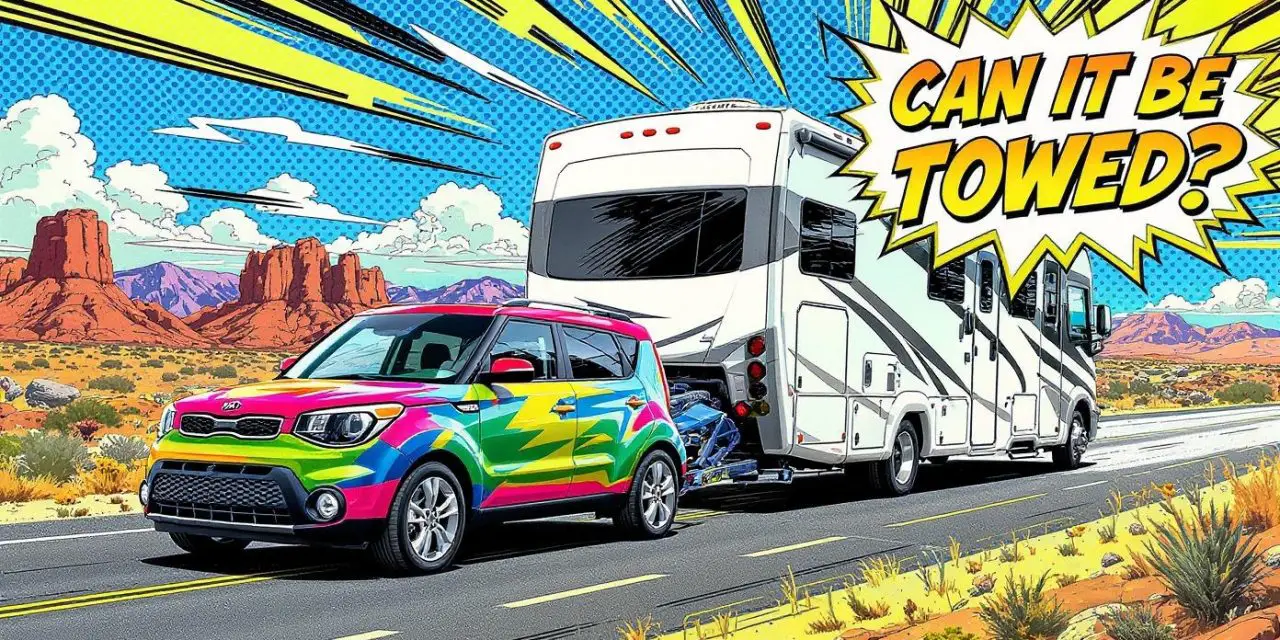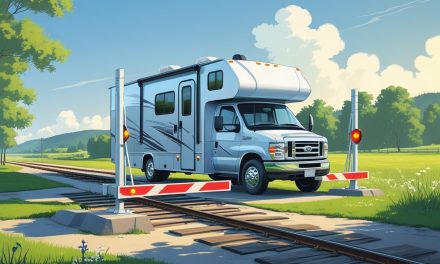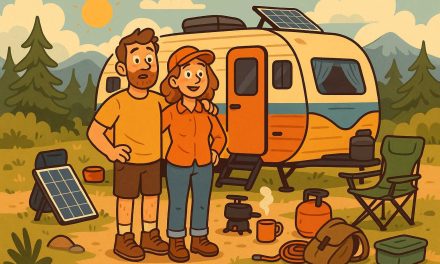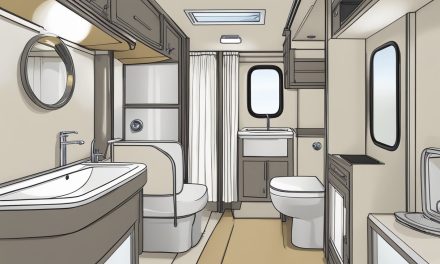Would you like to save this article?
Are you thinking about towing a Kia Soul behind your RV for your next big adventure? You’re not alone! Many RV owners love the idea of bringing along a smaller car for exploring towns and running errands once they’ve parked their big rig. The Kia Soul, with its boxy design and compact size, seems like it would be perfect for this job. But before you hook up and hit the road, there are some super important things you need to know. Getting this wrong could damage your car’s transmission or even cause a dangerous accident on the highway. In this guide, we’ll break down everything you need to know about whether can a Kia Soul be towed behind an RV, what equipment you’ll need, and how to do it safely.
1. The Big Question: Can You Actually Flat Tow a Kia Soul?
Here’s the straight answer: Some Kia Souls can be flat towed, but not all of them! It all depends on what kind of transmission your Soul has.
According to Kia’s official guidelines, only Kia Souls with manual transmissions can be safely flat towed behind an RV. The company also allows flat towing for certain models with 7-speed DCT (Dual Clutch Transmission) systems, but this varies by year.
Here’s what you need to know by transmission type:
Manual Transmission: CAN be flat towed – You’re good to go!
7-Speed DCT: CAN be flat towed – But only on front-wheel drive models
Regular Automatic (CVT): CANNOT be flat towed – Will damage the transmission
All-Wheel Drive Models: CANNOT be flat towed – Regardless of transmission type
Important numbers to remember: About 65% of RVers who choose to flat tow a vehicle pick cars that weigh less than 4,000 pounds. The Kia Soul weighs between 2,900-3,200 pounds depending on the model year, making it a great choice for weight-conscious RVers.
| Transmission Type | Flat Towable | Model Years Available | Special Requirements | Risk Level |
|---|---|---|---|---|
| Manual Transmission | Yes | 2010-2021 | Follow manual procedure | Low |
| 7-Speed DCT (FWD) | Yes | 2020-2025 | Specific DCT procedure required | Low-Medium |
| CVT Automatic | No | 2022-2025 | Use tow dolly instead | High (transmission damage) |
| All-Wheel Drive | No | 2020-2025 | Use car trailer instead | High (drivetrain damage) |
Trying to flat tow an automatic transmission Kia Soul is like trying to make a fish ride a bicycle – technically possible for about 5 minutes, but then things get very expensive very quickly! https://www.youtube.com/embed/MFT8TT5G2TQ
2. Understanding Different Kia Soul Model Years and What You Can Tow
Not all Kia Souls are created equal when it comes to towing! Different model years have different rules.
2020-2025 Kia Soul Models:
Base Model with Manual: Flat towable
Models with 7-Speed DCT: Flat towable (FWD only)
Models with CVT: NOT flat towable
All-Wheel Drive versions: NOT flat towable
2014-2019 Kia Soul Models:
Manual transmission models: Flat towable
Automatic transmission models: NOT flat towable
Statistics that matter: According to RV industry data, about 40% of RVers make the mistake of not checking their specific model year’s towing guidelines. This leads to approximately $3,000-$8,000 in transmission repair costs annually across the RV community.
| Model Year Range | Manual Trans | 7-Speed DCT | CVT Auto | AWD |
|---|---|---|---|---|
| 2010-2013 | Available/Towable | Not Available | Not Available | Not Available |
| 2014-2019 | Available/Towable | Not Available | Available/NOT Towable | Not Available |
| 2020-2025 | Available/Towable | Available/Towable | Available/NOT Towable | Available/NOT Towable |
The tricky part: Many Kia dealerships don’t always know the flat towing rules! Always check your owner’s manual or call Kia customer service directly with your VIN number to be 100% sure.
Asking a regular car salesperson about flat towing is like asking a goldfish about mountain climbing – they might give you an answer, but it probably won’t help you reach the summit!
3. What Equipment Do You Need for Towing a Kia Soul?
If your Kia Soul CAN be flat towed, you’ll need some special equipment to do it safely. Don’t try to cheap out here – this equipment keeps you and other drivers safe!
Essential Equipment List:
Tow Bar System ($800-$1,500)
- Blue Ox or Roadmaster are the most popular brands
- Must be rated for at least 5,000 pounds
- Self-aligning models are easier to use
Base Plate ($400-$800)
- Custom-made for your specific Kia Soul model year
- Bolts directly to your car’s frame
- Professional installation is highly recommended
Supplemental Braking System ($1,200-$2,500)
- Required by law in most states for vehicles over 3,000 pounds
- Activates your car’s brakes when you brake the RV
- Popular brands: Demco Stay-IN-Play, Blue Ox Patriot
Electrical Connection ($200-$400)
- Connects your car’s lights to your RV
- Includes turn signals, brake lights, and hazard lights
- Diode-protected to prevent electrical damage
Safety Cables ($50-$100)
- Required backup connection
- Must be crossed under the tow bar
- Rated for your vehicle’s weight
| Equipment Category | Low End | High End | Average |
|---|---|---|---|
| Tow Bar System | $800 | $1,500 | $1,150 |
| Base Plate | $400 | $800 | $600 |
| Supplemental Braking System | $1,200 | $2,500 | $1,850 |
| Electrical Connection | $200 | $400 | $300 |
| Safety Cables | $50 | $100 | $75 |
| Professional Installation | $500 | $1,200 | $850 |
| TOTAL INVESTMENT | $3,150 | $6,500 | $4,825 |
Buying cheap towing equipment is like buying a parachute from the bargain bin – it might work, but do you really want to find out the hard way? https://www.youtube.com/embed/Kl775H3Xtho
4. Step-by-Step: How to Properly Set Up Your Kia Soul for Flat Towing
Once you have all your equipment, you need to know exactly how to set everything up. Getting this wrong could damage your car or create a dangerous situation.
Pre-Trip Setup (Every Time!):
Step 1: Check Your Connections
- Inspect all electrical connections for damage
- Test brake lights, turn signals, and hazard lights
- Make sure safety cables are properly crossed
Step 2: Prepare the Vehicle
- Manual Transmission: Put in neutral, release parking brake
- 7-Speed DCT: Follow specific procedure in your owner’s manual
- Turn ignition to “ACC” position (not off, not on)
- Turn steering wheel lock to “OFF” position
Step 3: Attach the Tow Bar
- Line up RV and car carefully
- Attach tow bar to base plate
- Double-check all locking pins are secure
- Test the connection by gently pulling forward
Critical Safety Numbers:
| Safety Check | Frequency | Why It Matters |
|---|---|---|
| Connection Inspection | Every 2 hours | Prevents equipment failure |
| Complete Setup Check | Every 250 miles | Catches wear before failure |
| Maximum Speed | 65 mph | Prevents equipment stress |
| Turn Radius | 50% wider than normal | Prevents tow bar damage |
What NOT to do:
- Never tow in “Park” – this will destroy your transmission
- Don’t forget to turn off the parking brake
- Never skip the supplemental brake system
Setting up to flat tow is like doing the Electric Slide dance – there are specific steps, and if you mess up the order, everyone notices and someone’s probably going to get hurt!
5. The Real Costs: What You’ll Actually Pay
Let’s talk real money here. Many people think flat towing is “free” once you buy the equipment, but there are ongoing costs you need to know about.
Initial Setup Costs:
- Equipment: $2,500-$5,000
- Professional Installation: $500-$1,200
- Total Initial Investment: $3,000-$6,200
Annual Costs:
- Maintenance and Inspections: $200-$400
- Brake System Service: $150-$300
- Wear and Tear on Vehicle: $300-$600
- Total Annual Costs: $650-$1,300
Cost Comparison with Alternatives:
| Method | Daily Cost | Annual Cost (100 days) | 5-Year Total |
|---|---|---|---|
| Flat Towing | $6.50-$13.00 | $650-$1,300 | $3,250-$6,500 |
| Tow Dolly Rental | $50-$80 | $5,000-$8,000 | $25,000-$40,000 |
| Car Trailer Rental | $60-$100 | $6,000-$10,000 | $30,000-$50,000 |
| Rental Cars | $40-$70 | $4,000-$7,000 | $20,000-$35,000 |
Money-Saving Statistics: RVers who flat tow save an average of $2,400 per year compared to other vehicle transport methods, according to a recent RV industry survey.
Break-Even Point: Most RVers break even on their flat towing investment after 18-24 months of regular use.
Hidden Costs to Watch For:
- Increased fuel consumption: 10-15% more gas
- Tire wear on towed vehicle
- Insurance considerations
- Storage costs for equipment
Flat towing costs are like having a teenager – there’s the upfront investment, then surprise expenses that pop up when you least expect them, but somehow it’s still cheaper than the alternatives!
6. Safety First: Avoiding Common Flat Towing Mistakes
Safety should be your #1 priority when flat towing. Every year, there are about 50,000 towing-related accidents in the United States, and many could be prevented with proper knowledge.
The Top 7 Deadly Mistakes:
| Mistake | Problem | Cost of Mistake | Prevention |
|---|---|---|---|
| Wrong Transmission Mode | Towing in “Park” | $5,000-$8,000 | Follow manual exactly |
| No Brake System | Car doesn’t brake with RV | Collision/Death | Always use supplemental brakes |
| Exceeding Speed | Equipment failure | $2,000-$15,000 | Max 65 mph, cruise at 60 |
| Skipping Inspections | Equipment breaks free | $10,000+ liability | 15-min check every trip |
| Sharp Turns | Tow bar damage | $800-$2,000 | Wide turns, slow speed |
| Wrong Equipment | Inadequate rating | $3,000+ damage | Professional installation |
| Poor Weather Driving | Loss of control | Total loss | Avoid high winds/ice |
Critical Safety Statistics:
- 21% of towing accidents happen during the first hour of driving
- 35% of equipment failures occur due to improper installation
- 67% of towing problems are preventable with proper training
Emergency Procedures You Must Know:
- How to safely stop if brakes fail
- What to do if the tow bar breaks
- How to handle jackknifing situations
Making safety mistakes while flat towing is like wearing socks with sandals – it might seem harmless at first, but eventually everyone’s going to notice, and the consequences are more serious than you thought! https://www.youtube.com/embed/Oo3w5YtixbI
7. Alternatives to Flat Towing Your Kia Soul
What if your Kia Soul can’t be flat towed? Don’t worry! You have other options that might actually work better for your situation.
Option 1: Tow Dolly
- How it works: Front wheels on dolly, rear wheels on ground
- Cost: $50-80/day rental, or $2,000-4,000 to buy
- Pros: Works with ANY front-wheel drive car
- Cons: Takes longer to set up, storage needed
- Best for: Occasional RVers with automatic transmission cars
Option 2: Car Trailer
- How it works: Entire car loaded on trailer
- Cost: $60-100/day rental, or $3,000-6,000 to buy
- Pros: Works with ANY car, protects vehicle completely
- Cons: Requires bigger RV, harder to maneuver
- Best for: Expensive cars or long-distance travel
Option 3: Drive Separately
- How it works: Someone drives the car separately
- Cost: Gas money plus wear and tear
- Pros: No equipment needed, most flexible
- Cons: Requires two drivers, coordination challenges
- Best for: Short trips with multiple drivers
Option 4: Rent at Destination
- How it works: Rent a car when you arrive
- Cost: $30-60/day plus insurance
- Pros: No towing headaches, newer vehicles
- Cons: Expensive for long trips, availability issues
- Best for: Luxury RVers or short stays
Decision Matrix:
| Your Situation | Best Option | Estimated Cost | Why It Works |
|---|---|---|---|
| Manual transmission Soul | Flat towing | $4,000 setup | Cheapest long-term |
| Automatic Soul, frequent RVer | Buy tow dolly | $3,000 | Works with any FWD car |
| Automatic Soul, occasional RVer | Rent tow dolly | $50-80/day | No storage needed |
| Expensive/luxury Soul | Car trailer | $4,500 | Complete protection |
| Short trips only | Rental cars | $40-70/day | No equipment hassles |
Popular Statistics:
- 42% of RVers use flat towing
- 28% of RVers use tow dollies
- 18% of RVers use car trailers
- 12% of RVers use other methods
Choosing a towing method is like picking a superhero costume – they all have special powers, but some make you look ridiculous, and others cost way more than you expected!
Bonus Section: Real RVer Experiences and Tips
Here are some real-world tips from experienced RVers who tow Kia Souls:
“Best Practices from the Road”
- Always carry backup electrical connectors
- Keep a tire pressure gauge specifically for your towed vehicle
- Practice backing up in an empty parking lot before your first trip
- Join online forums like IRV2 for troubleshooting help
Common Questions Answered:
| Question | Answer | Why It Matters |
|---|---|---|
| Does flat towing void my warranty? | Usually no, if done per manufacturer guidelines | Saves expensive repairs |
| How much does it affect fuel economy? | Expect 10-15% reduction in MPG | Budget for extra gas costs |
| Can I back up with a flat towed car? | Never! You’ll damage the tow bar | Prevents expensive equipment damage |
| Do I need special insurance? | Check with your provider | May need additional coverage |
Final Thoughts: Is the Kia Soul Right for Your RV Adventures?
So, can a Kia Soul be towed behind an RV? The answer is a definite “maybe!” If you have the right transmission (manual or 7-speed DCT) and you’re willing to invest in proper equipment and training, the Kia Soul can make an excellent toad (that’s RV slang for “towed vehicle”).
The Bottom Line:
Pros:
- Great size and weight for RV towing
- Good fuel economy when driving separately
- Reliable and affordable to maintain
- Quirky design that stands out at campgrounds
Cons:
- Limited transmission options for flat towing
- Requires significant upfront investment
- Need professional installation for safety
- Not all model years are compatible
Remember, safety should always be your top priority. When in doubt, consult with professional RV technicians and always follow manufacturer guidelines exactly.
Happy RVing, and may your adventures be safe and your tow bar never break!
Sources:
Midwest Kia – Dinghy Towing Guide- iRV2 Forums – Kia Soul Towing Experiences
- Good Sam Community – RV Towing Advice
- Kia Soul Forums – Transmission Information
- etrailer.com – Flat Towing Equipment Guide
- CURT Manufacturing – Dinghy Towing Statistics
- Blue Ox – Towing Equipment Specifications
- Roadmaster Inc. – Popular Flat Towed Vehicles
- National Highway Traffic Safety Administration – Towing Safety Data
- RV Life Magazine – Towing Best Practices
- Camping World – RV Towing Guide





